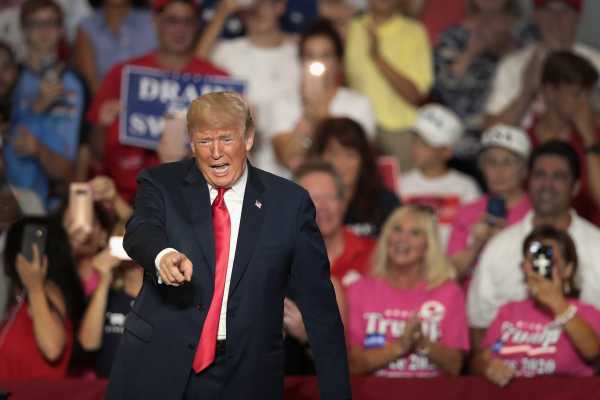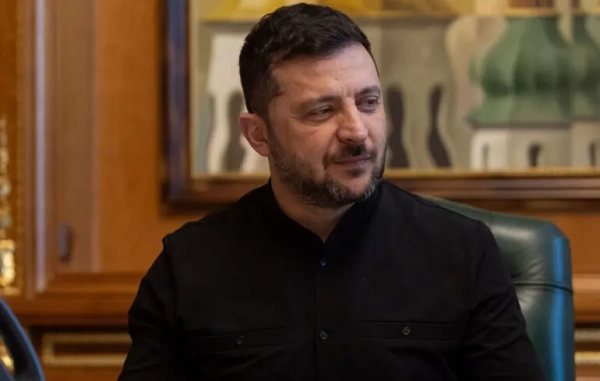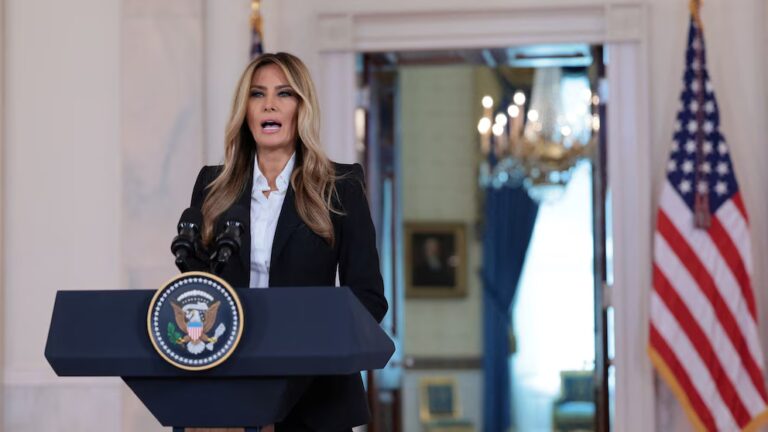
President Donald Trump really wants the American people to believe his trade war and tariffs are all working out exactly as planned — and ignore mounting evidence that might not be the case.
Trump fired off a series of tweets over the weekend celebrating his trade aggressions. His administration has imposed tariffs on a variety of imports from China, Canada, Mexico, the European Union, and Japan, and on Sunday, Trump said they’re “working big time.” Whatever the outcome — companies pay tariffs, or they start building in the US — he said it means “jobs and great wealth.” He also declared that tariffs will help the US pay down the deficit. (It won’t.)
So far, Trump has targeted steel and aluminum imports from many American allies and put tariffs on $34 billion of Chinese goods, this week floating the idea of increasing them. China has retaliated with tariffs of its own and is threatening even more, and while Trump reached a truce with the European Union to pull back from a full-blown trade war, a grander trade deal between the US and the US is hardly guaranteed. In fact, the renegotiated, better trade deals Trump promised on the campaign trail have largely failed to materialize, with the exception of an agreement reached with South Korea in March.
But Trump keeps insisting everything’s going just fine.
In tweets on Saturday, Trump said that tariffs will make the United States “much richer than it is today” and cited the recent decline in China’s stock market as evidence of their success. “We are Winning, but must be strong!” he wrote.
There are some winners in Trump’s trade war. The United States steel industry, for example, has benefited from rising steel prices (although Trump for some reason keeps lying about US steel opening new mills). The US economy is doing well, though it’s unlikely much of that is a direct result of Trump’s trade tactics.
But there are a lot of losers, too — farmers in need of a bailout, manufacturers who use aluminum and steel in their supply chains, American consumers discovering the “tax” tariffs impose is actually on them.
As Trump continues to insist his trade tactics are going spectacularly, here are five pieces of evidence that might not be the case.
1. Farmers needed a $12 billion bailout
“Tariffs are the greatest,” Trump declared in a tweet in late July. Hours later, reports emerged that his administration is planning to give $12 billion in emergency aid to farmers hurt by those “great” tariffs.
As Vox’s Tara Golshan laid out, the agriculture industry is among the hardest-hit sectors as foreign countries retaliate with tariffs of their own. China, Mexico, and Canada have responded to the US’s measures with taxes on American soybeans, dairy, pork, apples, and potatoes, among other products. Prices for soybeans have dropped to a 10-year low, and soybean exporters rushed to get their product out of the country earlier this year ahead of the impending trade war.
Trump’s trade tactics, effectively, have necessitated a $12 billion farmer bailout.
2. Other countries are making trade deals without the US
After taking office, Trump announced that he would withdraw the United States from the Trans-Pacific Partnership (TPP) and promised to make good on his campaign-trail promises to renegotiate new deals he deems more fair, including an overhaul of the North American Free Trade Agreement (NAFTA). That’s not exactly how it’s worked out — there’s still no new NAFTA, and the bilateral deals Trump has focused so much of his rhetoric on have largely failed to materialize.
What’s more, other countries are moving on without the US.
Japan and the EU in July agreed to an outline for a trade deal that would rival the size of NAFTA — a consequence, in part, of Trump’s TPP withdrawal. The same goes for the 11-country Asia-Pacific trade agreement signed in March, which will reduce tariffs on nations that together make up more than 13 percent of the global economy. (Had the US signed on to the deal under the TPP, it would have represented 40 percent.) China has also been shopping for new trade agreements as the US has stepped back from the global stage.
“Other countries now have very strong incentives to do business independent of the US and independent of the dollar,” Moody’s Analytics economist Mark Zandi recently told me.
3. The tariffs are showing up in consumer prices and business decisions
Tariffs are taxes imposed on goods and services. Trump’s case is that it’s foreign companies that pay them, but ultimately, they often wind up being shouldered by US consumers. And there’s evidence that’s what’s happening now.
Aluminum and steel tariffs could cost the US beer industry $348 million per year alone, according to the Washington Post, citing the Beer Institute. The rest of the beverage industry is taking taking a hit, too: Coca-Cola, for example, has said it has to raise prices. The National Association of Home Builders has said that Trump’s tariffs on softwood lumber from Canada have increased the cost of building a home by $7,000. Machinery maker Caterpillar has said it will raise prices. Winnebago is upping the cost of its RVs, too, and washing machine prices have spiked.
Harley-Davidson has said Trump’s trade tactics will result in it moving some production overseas altogether. Mid-Continent Nail announced layoffs because of them.
4. The tariffs aren’t making a dent in the United States’ debt
Trump’s claim on Sunday that the tariffs would allow the US to start paying down “large amounts” of the US’s $21 trillion debt isn’t true.
The amount of tariffs the president has imposed so far — about $85-billion worth of foreign goods — isn’t enough to make a dent in the US’s $21 trillion deficit. The Washington Post’s Heather Long did the math and found that Trump’s tariffs would raise about $21 billion at most, or 0.1 percent of the total debt:
5. We still don’t know what winning looks like for Trump
As eager as Trump is to declare a victory lap on trade, it’s still unclear what exactly a victory would entail.
The aluminum and steel tariffs were imposed under the justification of protecting national security, but they are hitting the US’s closest allies and partners and could be ultimately undermining America’s goal to put pressure on China. It’s unclear whether the national security justification is anything more than an excuse for Trump to do something he already had his mind set on doing.
Trump got some concessions out of European Commissioner Jean-Claude Juncker in July, including a pledge that the EU will import more US soybeans and liquefied natural gas, while the US said it would stop future tariffs while they continue to negotiate over the steel and aluminum taxes. Still, it’s unknown what the broader goal is here.
And on the China front, the trade war seems to be ratcheting up, with both sides considering more measures. Multiple experts recently told me that there’s still an off-ramp to the trade war, but a big part of the problem is that no one knows what Trump really wants — including, perhaps, Trump himself. The president has focused much of his energy on talking about trade deficits, but economists say he seems to sometimes misunderstand them, and he’s never laid out an exact picture of what, in his mind, constitutes a good trade deal.
“There’s always a way out of these things, there’s always a deal to be done,” Edward Alden, senior fellow at the Council on Foreign Relations, recently told me. “But it’s very hard with the Trump administration to figure out what those deals might look like.”
For now, it looks like Trump’s just going to keep insisting everything’s going well.
Sourse: vox.com






